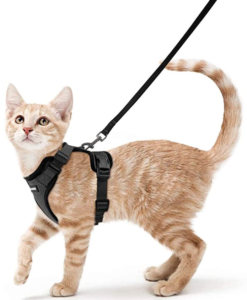There are many benefits to raising your pet as an indoor cat. However, it can limit your cat’s experiences. A lot of owners of indoor cats can feel a little guilty that their pet doesn’t get too much time outside. Even with windows and catios, you might want to give your cat a little more excitement. While it is more commonly associated with dogs, it is possible to walk your cat on a leash. A lot of cats really enjoy a walk. While it isn’t for every pet, it is a good way to give your cat some new experiences.

The main difficulty comes with actually getting your cat to walk on a leash. Dogs seem to have muscle memory from birth about how leashes work, some do struggle. Although, to a cat the sensation is quite different. They aren’t really used to being tethered up to something. Your cat might enjoy getting outside with you, but it could cause real problems if they’re not very keen on using a harness and leash. You can help this by training your cat properly to walk on a leash. This is quite easy to do, but it does take some perseverance.
You also need to make sure you’re using an appropriate leash and harshness. Some of them can be very insecure. The last thing you want when walking your cat is an escape attempt! If you think your pet would benefit from some walks, you need a secure and comfy lead that your cat is trained to walk with.
What Harness and Leash Do You Need?
The first step to training a cat how to walk on a leash is to use the right leash. It can be difficult to teach your cat to relax with a tether attaching the two of you if the leash is uncomfortable. Equally, you want your pet to be securely fastened on the leash. If they’re not, then it might be hard to walk them at all. These are the things you need to look for in a cat leash.
Harness or Collar?
Much like with walking dogs, you need to decide whether you’re going to be using a leash attached to a collar or to a harness. When you’re walking a cat, a harness is the better choice. This gives you more control over them. Cats aren’t usually comfortable without control of where they’re going. They can make them pull on the leash even when trained. Since they’re more fragile, this can really hurt a cat’s neck if they’re wearing a collar.
This is a good reason to use a harness instead of a collar. One specifically designed for a cat’s body shape will let them move more comfortably than attaching a leash to their collar.
Adjustable
Not every cat is the same size! Your cat might be on the bigger size, because of their breed or just the way that they eat! In any case, your harness needs to be adjustable.
Most harnesses on the market are adjustable for different cat sizes. However, you should be sure to check. If you have a particularly large cat or small, you will need to find one that specifically fits this shape.
Material
A cat doesn’t tend to like the lack of control that comes with a harness and lead. To help this, you can use a lightweight material. This will weigh less on your car and help them feel more comfortable in the harness. Unlike with a dog, this isn’t just a piece of material they ignore. How the harness feels on them can really flavour your cat’s enjoyment of a walk.
A lightweight material that keeps them secure is ideal for a cat harness. However, it all comes down to what your cat is comfortable in.
Escape-Proof
This is pretty important! A cat has sharp nails and can contort itself in different ways to a dog. This can make even a secure looking harness something they’re able to wriggle out of.
You need to be able to securely tighten their harness. This should prevent any escape attempts! However, if you find your cat trying to escape from their harness really frequently on walks despite training, they might just not be enjoying walking.
Choosing a Lead for Your Cat
If your harness fits all of those requirements, then the next step is to choose a lead to use for your cat! The lead isn’t as important as the harness really. You don’t have as much to work with when choosing a leash. However, there are some simple things to keep in mind. Use a light material but one that you can keep hold of. A chain lead isn’t going to be comfortable for your cat. You should ensure the lead is of a good enough length to allow your cat plenty of freedom, and that it is comfortable.

View on Amazon
How to Teach Your Cat to Walk
Teaching your cat to walk on a leash is something of a process. This will be easier if you’ve done other training with your pet in the past. Training a cat is similar to training a dog, but it takes more patience and reinforcement. If you’ve previously done training with your cat, you can use the same methods of reinforcement when training them to walk on a lead.
If you haven’t trained your cat before, you will have to test out different ways of reinforcing good behaviour. Most cats will respond well to a food treat as a reward. Some cats will also enjoy verbal praise for their actions. Test things out and see what works with your cat.
If you’re aiming to teach your cat to walk on a leash, you’ve got to start small…
Getting Your Cat Used to the Lead and Harness
The first step of teaching your cat to walk on a lead is to get them used to having their harness on. You should put your harness on your cat while they are still at home. They might initially resist this. If they are too uncomfortable, try adjusting the harness until it is comfortable for them. Even if it is not tight enough to take them out safely, you can get them used to wearing it.
After your cat has become comfortable wearing their harness around the house, you can tighten it up so you can safely use it outside the house. You then need to get your cat used to using the lead.

How to Train a Cat to Walk on a Leash
You need to teach your cat to walk on a leash inside at first. You can’t jump straight into full walks. When they’re used to having their harness on, attach a lead. You then need to try and lead them around your house with it on. If your cat is really resistant to this idea, try following them around the house with the lead for a while. This should get them used to the sensation without taking away any control since they’re deciding where to move.
From here, you can transition to actually leading your cat around. Be sure to praise and give them treats for co-operating. Keep these training sessions short, but consistent for them to build up your cat’s confidence walking with a leash attached.
Getting Outdoors
Once your cat has learnt all of this, they can try something a bit more complicated. It is finally time to take your cat outdoors!
Start by walking them in your garden, or another familiar area if you don’t have one. This might be a big step for your cat. Be sure to reward them for anything they do that is right. However, if this is a bit much for your cat then take it in baby steps.
When your cat begins to try to struggle out of the harness, you can probably end your training for the day. This should limit the amount of time they’re uncomfortable walking, and help them enjoy going for walks. Be aware that if you walk your cat in a loud or busy area, this is going to be much harder. It is easier to stick to quiet places at first until your cat becomes more familiar.
Going Further Away
Once your cat is fairly familiar with their little walks, you can start going a bit further. Your cat will enjoy exploring and getting to know new places, but you need to take it one step at a time. Unlike a dog who jumps right in, cats can find it a bit much at once. Make sure you reward them plenty for walking well, and they should have fun gradually seeing more of the world.
Do You Need to Walk Your Cat?
Training a cat to walk on a leash is difficult, but it is achievable. However, it is worth considering whether you need to walk your cat. If training them to walk seems to be more for your benefit then your cat’s, then it might not be the right move for them.

Going for walks can be a great way to give your cat a bit more stimulation. However, it isn’t for every pet. Some cats will not enjoy the loss of control from walking, this can make going for a walk more uncomfortable than it is fun for them. If your cat doesn’t appear to enjoy or want to walk on a leash, then you shouldn’t feel bad about not walking them. An enclosed garden for supervised play or even a catio can be a good compromise for cats like this. They get outside without a lead but stay safe.
Otherwise, walks can be a lot of fun for you and your pet.








